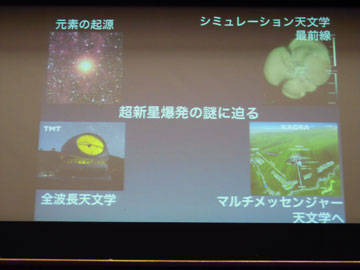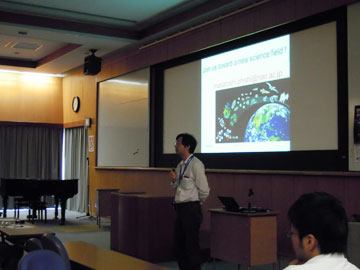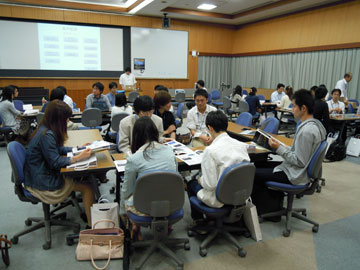[Speaker 1]
Ayumu Matsuzawa
M2, SOKENDAI, Mitaka(supervisor : Satoru Iguchi)
[Title]
Evaluation of pointing error on ALMA ACA antenna
[Abstract]
The pointing error is difference between actual direction and directed direction of the antenna. I evaluate the activity of scientific performance by pointing error for ALMA antenna. The pointing error of ALMA antenna has three components: The components of antenna, the component of the optical pointing telescope and the components of the atmosphere. The purpose of my research is extract and evaluates the only component of radio antenna. Because, the component of antenna specification be established.
Therefore, the component of antenna can correctly evaluate rather than other two components.
For evaluate the pointing error, I estimate the pointing error from measurement data. The measurement of pointing error uses the optical pointing telescope (OPT). OPT installed in surface of antenna, and shooting a star by CCD in OPT. In the image of CCD, the pointing error assumed the difference center of image between centroid of star. But, this image included same noise. I made a program for remove the noise in image. I confirm that this program perform in ideal image as expected.
The component of antenna has some components (wind, thermal, servo, meterology). For extract these components, I measure the pointing error by Long tracking (measure the pointing error when tracking the one source over 15min). It can extract using the data of resolver and thermocouple. Now, I measure the pointing error by many long tracking, also I will measure the pointing error by Fast switching (measure the pointing error when the antenna is moving fast). After this, I will evaluate the component of radio antenna from pointing error. By this research, I expect improve the precision of pointing error for ALMA antenna.
————————————————————
————————————————————
[Speaker 2]
Nagisa Shino
D1, SOKENDAI, Mitaka(supervisor : Mareki Honma)
[Title]
Testing the formation scenario of massive star by CH3OH maser
[Abstract]
Now classⅠ CH3OH maser is thought to be associated with outflow, while classⅡ CH3OH maser is thought to be associated with accretion disc.
If this is true, classⅠ CH3OH maser is expected to be distributed perpendicularly with respect to rotating disk.
Detecting (or rejecting) this will play a major role in understanding the scenario of massive star formation.
To do this, we plan to observe distributions of two classes of CH3OH masers with VLBI. For that purpose, first we have to look fortarget sources in which both of classes are detected.
We performed the single-dish observations of both classes of CH3OH maser using Nobeyama 45m and Yamagucchi 32m telescopes.
As a result, we discovered 89 sources detected in both classes.
月別アーカイブ: 2012年6月
The outflow from accretion disk around the Black Hole / Finding Brown Dwarfs in star formation region with subaru telescope
[Speaker 1]
Katsuya Hashizume
[Title]
The outflow from accretion disk around the Black Hole
[Abstract]
The accretion disks around Black Holes(BHs) are believed to drive high energy astrophysical phenomena , such as high-energy radiation, disk outflows, and jets of Active Galactic Nuclei and black hole binaries.
But, structure of the disks and mechanisms of driving outflow have poorly understood. Especially, super-Eddington accretion disks, of which luminosity exceeds the Eddington luminosity, is a hot debated issue.
If the super-Eddington disks are feasible, the ultra luminous X-ray sources are explained without assuming intermediate mass black holes.
By two-dimensional radiation-hydrodynamics (2D-RHD) simulations, super-Eddington accretion disks around BHs are successfully reproduced, implying that quasi-steady super-Eddington accretion is possible (Ohsuga et al. 2005).However, the computational domain of the simulations is restricted tobe 500 Rs (Schwarzschild radius).Thus, the behavior of outflows at the distant region (>500Rs) is not investigated.
The structure of the super-Eddington flows might change if the outflowing matter of >500Rs get back to the vicinity of the black hole.
In order to understand more realistic structure and dynamics of the super-Eddington flows, it is needed to reperform 2D-RHD simulations with much larger computational domain.
In this talk, I present the fundamental mechanisms of BH accretion disks and outflows,and also my research plan of master thesis.
————————————————————
————————————————————
[Speaker 2]
Daehyeon Oh
[Title]
Finding Brown Dwarfs in star formation region with subaru telescope
[Abstract]
TBD
国立天文台特別公開講座/総研大天文科学専攻入試ガイダンスを開催
2012年5月26日に(土)に国立天文台(三鷹キャンパス)で、特別公開講演および総研大入試ガイダンスが行われました。今年は、30名以上の方々にご参加いただき、大変な盛り上がりを見せました。また、学生のみならず一般の方も参加され、日本の天文学を国立天文台から社会に発信する良い機会になりました。
特別公開講演では、「新領域を切り開く天文学」をテーマとして、ハワイ観測所の宮崎聡准教授、理論研究部の田中雅臣助教、天文データセンターの大石雅寿准教授による公演が行われました。装置開発からシミュレーションに至るまで最先端の研究を身近に感じられ、参加者にとって大変有意義な時間となりました。また、参加者による質疑応答では、今後日本の天文学がどのように発展して、どんな可能性を秘めているのか、白熱した議論が繰り広げられました。
教員との相談会では、興味・関心のある分野の教員に直接話を聞くことができ、大学院の概要,入試や入学後の学生生活,実際の研究活動などの質疑応答が活発に行われました。また、院生とも交流する場が設けられ、実際の研究生活や、授業、実習などについて詳しく聞けるとても有意義な場となりました。このように、多くの方々にご参加いただけたことで、積極的な質疑応答が交わされ、参加者にも講演者にも大変意義のあるガイダンスとなりました。
 田中助教の講演内容
田中助教の講演内容
 参加者から質問を受ける大石准教授
参加者から質問を受ける大石准教授
 教員との相談会の様子
教員との相談会の様子
 ハワイからもskypeで接続して対応
ハワイからもskypeで接続して対応
Investigating the coevolution between SMBHs and Galaxies at z~3 / Morphological Evolution of Passively Evolving Early-type Galaxies at z~2
[Speaker 1]
Yuriko Saito
[Title]
Investigating the coevolution between SMBHs and Galaxies at z~3
[Abstract]
In the local universe, there is a tight correlation between the masses of super massive black holes (SMBHs) and stars in the spheroidal components (bulge and elliptical galaxies), suggesting that their formation is physically closely related. Various models assuming different physical mechanisms are proposed to explain the observational result at z=0.
Since these models predict different redshift evolution of the SMBH-spheroid mass ratio, it is important to observationally constrain the mass ratio at high redshift. Since the predicted difference becomes larger at higher redshift, going to higher redshift is better to distinguish among these models, but at the same time observational difficulties increase at higher redshift.
By taking into account these factors, we have concluded that z=3-3.5 is the best redshift range.
However, previous studies have mostly been limited to z<2.
We have embarked on (1) systematic near-infrared spectroscopy of z=3-3.5 QSOs, to derive the SMBH masses, based on the the Balmer beta emission line width and nearby continuum luminosity, using 3--4m telescopes, and (2) Subaru LGS-AO near-infrared multi-color imaging observations, to estimate spheroidal stellar masses in the host galaxies of these QSOs.
The use of Balmer beta line, PSF-stable Subaru LGS-AO, and multi-color imaging data make our study the most reliable and promising to investigate the redshift evolution of SMBH-spheroid mass ratio and to observationally constrain the physical mechanism behind the correlation.
In this talk, I will present our strategy and current progress of this project.
------------------------------------------------------------
------------------------------------------------------------
[Speaker 2]
Sumire Tatehora
[Title]
Morphological Evolution of Passively Evolving Early-type Galaxies at z~2
[Abstract]
Understanding the formation of massive elliptical galaxies is an unsolved problem. The discovery of a widespread population of passively evolving early-type galaxies (ETGs) at z>1.4 have proved that quenching star formation in most massive galaxies was well under way by z~2. And such objects are extremely compact, having much smaller effective radii compared to local ETGs with the same stellar mass, while massive ETGs
with similar effective radii have also been found. If we understand their dynamical and structural properties in detail, it is important to measure the stellar velocity dispersion of galaxies. However the number of high-z ETGs with measurement of the velocity dispersion is still extremely small.
So we have deep NIR spectroscopic observations of 33 massive passive BzK-selected galaxies (pBzKs) from the COSMOS field using Subaru/MOIRCS. In this talk, I will present progress of an analysis.